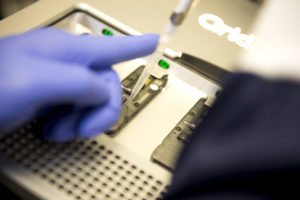Using cutting-edge genomic sequencing techniques, researchers at the University of Oxford have identified almost all the genomic variation that gives people resistance to 13 of the most common tuberculosis (TB) drug treatments.

The Comprehensive Resistance Prediction for Tuberculosis International Consortium (CRyPTIC) research project has collected the largest ever global dataset of clinical M. tuberculosis samples from across the world consisting of 15,211 samples from 27 countries on five continents.
Using two key advances: a new quantitative test for drug resistance and a new approach which identifies all the genetic changes in a sample of drug-resistant TB bacteria, the researchers have generated a unique dataset which the team has used to quantify how changes in the genetic code of M. tuberculosis reduce how well different drugs kill these bacteria that cause TB.
These innovations, combined with ongoing work in the field, promise to profoundly improve how patients with TB are treated in the future.
“This innovative, large-scale, international collaboration has enabled us to create possibly the most comprehensive map yet of the genetic changes responsible for drug resistance in tuberculosis,” said Derrick Crook, Professor of Microbiology at the University of Oxford.
In a series of nine new pre-print manuscripts, each documenting a different aspect of how the CRyPTIC project has advanced the field, the researchers reveal:
- How the new drug resistance tests should be interpreted and how a massive citizen science project helped solve this problem
- How the new drug resistance tests should be interpreted and how a massive citizen science project helped solve this problem
- How a new approach to detecting and describing genetic changes in the whole TB genome sequence improved the way genetic changes driving drug resistance can be detected
- How these data were used to scan the TB genome sequence for changes not previously known to cause drug resistance
- How individual mutations, and combinations of mutations, can be related not just to blunt measures of ‘resistance’ or ‘susceptibility’, but also to even minor changes in the way a drug kills M. tuberculosis, thereby reducing the effectiveness of treatment with special attention being paid to two novel compounds being used to treat tuberculosis.
- How artificial intelligence can predict drug resistance from signatures in the DNA sequence
- How these data contributed to the first list of drug resistance mutations in the TB genome to be endorsed for global use by the World Health Organization

These results aim to help improve control of tuberculosis and facilitate the World Health Organisation’s End TB Strategy through better, faster and more targeted treatment of drug-resistant tuberculosis via genetic resistance prediction, paving the way towards universal drug susceptibility testing.
The data, which are now freely available, can be used by the wider scientific community to improve our understanding of drug resistance in TB and how to best treat this important disease. As well as the Oxford BRC, this project is funded by MRC Newton Fund, Wellcome Trust, and Bill & Melinda Gates Foundation.